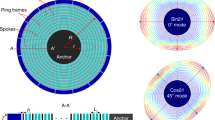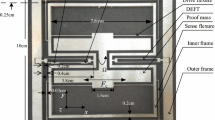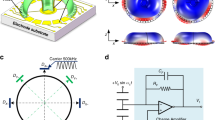Abstract
The mechanical sensitivity (\(S_{mech}\)) is an important performance for ring-like disk resonator gyroscope (RDRG). To provide guidelines for improving \(S_{mech}\), the reliable expression of \(S_{mech}\) is derived by taking into account frequency split and difference of effective mass. The design strategy indicates the main way to improve \(S_{mech}\) is reducing effective stiffness and frequency split. Then a novel gear-like disk resonator gyroscope (GDRG) is designed by replacing circular rings of RDRG with meander-shaped rings consisting of linear beams. Afterwards, the characteristics between RDRG and GDRG are compared. For gyroscopes fabricated ideally, GDRG has a decrease of 58.40% on effective stiffness, an increase of 49.51% on quality factor (Q) and an increase of 694.28% on \(S_{mech}\), comparing with RDRG. For actual fabricated gyroscopes, GDRG has much less frequency split than RDRG due to its much higher immunity to crystal orientation error and fabrication errors. Affected by these errors, effective stiffness and Q have small deviations from the values of gyroscopes fabricated ideally, \(S_{mech}\) decreases greatly and \(S_{mech}\) of GDRG is always much higher than that of RDRG. These results have verified GDRG can achieve high \(S_{mech}\) due to its small effective stiffness, small frequency split and high Q. The ideas and methods described in this paper can also be applied to other similar gyroscopes.











Similar content being viewed by others
References
Acar C, Shkel A (2009) MEMS vibratory gyroscopes: structural approaches to improve robustness. MEMS reference shelf. Springer, Boston
Ahn CH, Ng EJ, Hong VA, Huynh J, Wang S, Kenny TW (2015) Characterization of oxide-coated polysilicon disk resonator gyroscope within a wafer-scale encapsulation process. J Microelectromech Syst 24(6):1687–1694
Challoner AD, Ge HH, Liu JY (2014) Boeing disc resonator gyroscope. In: IEEE/ION position, location and navigation symposium (PLANS), Monterey, CA, USA, pp 504–514
Chang CO, Chang GE, Chou CS, Chien WTC, Chen PC (2008) In-plane free vibration of a single-crystal silicon ring. Int J Solids Struct 45(24):6114–6132
Cho JY (2012) High-performance micromachined vibratory rate- and rate-integrating gyroscopes. Dissertation, University of Michigan
Davin J (2018) Simulating the performance of ring-based coriolis vibrating gyroscopic sensors. Microsyst Technol 25(1):139–149
Fan B, Guo S, Cheng M, Yu L, Zhou M, Hu W, Zheng F, Bu F, Xu D (2019a) Frequency symmetry comparison of cobweb-like disk resonator gyroscope with ring-like disk resonator gyroscope. IEEE Electron Device Lett 40(9):1515–1518
Fan B, Guo S, Cheng M, Yu L, Zhou M, Hu W, Chen Z, Xu D (2019b) A novel high-symmetry cobweb-like disk resonator gyroscope. IEEE Sens J 19(22):10289–10297
Kim J, Cho DI, Muller RS (2001) Why is (111) silicon a better mechanical material for MEMS? In: Transducers 2001, Berlin, pp 662–665
Li Q, Xiao D, Zhou X, Xu Y, Zhou M, Hou Z, He K, Zhang Y, Wu X (2018) 0.04 degree-per-hour MEMS disk resonator gyroscope with high-quality factor (510 k) and long decaying time constant (74.9 s). Microsyst Nanoeng 4:32
Li M, Ding X, Qin S (2019) Design of a novel lower-noise tunneling magnetoresistance micromachined gyroscope. Microsyst Technol 25(4):1447–1454
Nitzan S, Ahn CH, Su TH, Li M, Horsley DA (2013) Epitaxially-encapsulated polysilicon disk resonator gyroscope. In: 26th IEEE international conference on micro electro mechanical systems (MEMS), Taiwan, China, pp 625–628
Nitzan SH, Zega V, Li M, Ahn CH, Corigliano A, Kenny TW, Horsley DA (2015) Self-induced parametric amplification arising from nonlinear elastic coupling in a micromechanical resonating disk gyroscope. Sci Rep 5:9036
Qin Z, Gao Y, Jia J, Ding X, Huang L, Li H (2019) The effect of the anisotropy of single crystal silicon on the frequency split of vibrating ring gyroscopes. Micromachines 10(2):126
Su TH (2015) Approaches for low noise sensing in MEMS disk gyros. Dissertation, University of California
Su TH, Nitzan SH, Taheri-Tehrani P, Kline MH, Boser BE, Horsley DA (2014) Silicon MEMS disk resonator gyroscope with an integrated CMOS analog front-end. IEEE Sens J 14(10):3426–3432
Xiao D, Zhou X, Li Q, Hou Z, Xi X, Wu Y, Wu X (2016) Design of a disk resonator gyroscope with high mechanical sensitivity by optimizing the ring thickness distribution. J Microelectromech Syst 25(4):606–616
Xia D, Huang L, Zhao L (2019) A new design of an MOEMS gyroscope based on a WGM microdisk resonator. Sensors (Switzerland) 19(12):2798
Xie J, Hao Y, Yuan W (2019) Energy loss in a MEMS disk resonator gyroscope. Micromachines 10(8):493
Xu Y, Li Q, Zhang Y, Wu X, Xiao D (2020) Honeycomb-like disk resonator gyroscope. IEEE Sens J 20(1):85–94
Zener C (1938) Internal friction in solids II. General theory of thermoelastic internal friction. Phys Rev 53:90–99
Zhou X, Li Q, Xiao D, Hou Z, Wu X (2016a) The mechanical sensitivity optimization of a disk resonator gyroscope with mutative ring thickness. In: 2016 IEEE international symposium on inertial sensors and systems (ISISS), Laguna Beach, CA, USA, pp 54–57
Zhou X, Xiao D, Wu X, Wu Y, Hou Z, He K, Li Q (2016b) Stiffness-mass decoupled silicon disk resonator for high resolution gyroscopic application with long decay time constant (8.695 s). Appl Phys Lett 109(26):263501
Zhou X, Xiao D, Li Q, Hou Z, He K, Chen Z, Wu Y, Wu X (2018a) Decaying time constant enhanced MEMS disk resonator for high precision gyroscopic application. IEEE/ASME Trans Mechatron 23(1):452–458
Zhou X, Xiao D, Li Q, Hu Q, Hou Z, He K, Chen Z, Zhao C, Wu Y, Wu X, Seshia A (2018b) Investigation on the quality factor limit of the (111) silicon based disk resonator. Micromachines 9(1):25
Acknowledgements
This work was supported by the National Natural Science Foundation of China (Grant no. 61574093), the National Key Laboratory Fund (Grant no. 614280504010317) and Professional Technical Service Platform of Shanghai (Grant no. 19DZ2291103).
Author information
Authors and Affiliations
Corresponding author
Additional information
Publisher's Note
Springer Nature remains neutral with regard to jurisdictional claims in published maps and institutional affiliations.
Rights and permissions
About this article
Cite this article
Feng, J., Zhang, W., Gu, L. et al. Design of a novel gear-like disk resonator gyroscope with high mechanical sensitivity. Microsyst Technol 27, 2715–2722 (2021). https://doi.org/10.1007/s00542-020-05047-6
Received:
Accepted:
Published:
Issue Date:
DOI: https://doi.org/10.1007/s00542-020-05047-6




